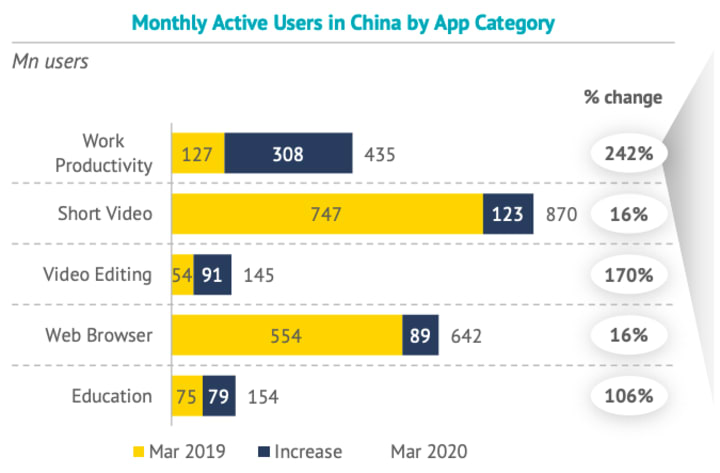CHINA: INTERNET USE AND TECHNOLOGICAL TRENDS
China continues to focus on technology to increase internal development and rival other nations. It is a strongly managerial strategy, which finds fertile ground in the propensity to adopt citizens. This is what emerges from the report of the South China Morning Post, full of data and food for thought, which I try to summarize.

Using the internet and digital payments
China has surpassed 900 million Internet users, more than the USA, Russia, Mexico, Germany, UK, France and Canada combined. Yet there is still 37% of the unconnected population, so growth is far from over.
Two elements tell more than others the level of digital propensity: almost all access the internet on the move (897 million) and, of these, the great majority pay using their smartphones and apps such as WeChat Pay and AliPay (765 million). Digital payments are a habit for 53% of the Chinese population compared to 21% of the United States.

The mass adoption of 5G
2020 should be the year of mass adoption of 5G in China. A completed infrastructure worth $ 25 billion and a flood of 5G smartphones for all budgets. In addition, the propensity of consumers to switch to the network is 70%, while in the United States it is 42% and in the United Kingdom 23%. I don't have the Italian data, but the level of psychological terrorism here is very high, with mayors blocking infrastructure works as a precaution. Meanwhile, during the pandemic, 5G allowed doctors in Beijing to collaborate with those in Wuhan and dozens of designers to work remotely to complete two Covid hospitals in record time.
Web services and Covid-19
Web services in China are highly developed, in some cases more than western ones, also because here the digital attitude is very high. They range from search to advanced health apps. For each type of service there is a lively internal competition.


Here too, the lockdown has led to greater consumption of the network. The hours of daily stay have increased from 5.6 in March 2019 to 7.2 this year. In particular, the 308 million users of productivity applications such as Alibaba's DingTalk (also used by 50 million students), Tencent's WeChat Work and Tencent Meeting have increased.
The most used apps have remained those that allow you to create short videos like Douyin. Users are estimated to have reached 870 million (+ 16% compared to the previous year).

During the period, the development and testing of innovative applications was accelerated. For example, citizens have been assigned a personal QR Code of different color depending on their state of health. The code, quickly scanned by health and police operators, represented the result of Big Data-based algorithms, including personal ones, such as trips made, time spent in risky areas and relationships with potential infected persons.
The use of Artificial Intelligence made by Yitu Technology, Huawei and Alibaba is interesting to allow faster reading of the CT scans to diagnose the coronavirus. A scan, made of over 300 images, can be evaluated by a doctor in 5-15 minutes, while Alibaba's AI system would take 20 seconds.
Live Streaming phenomenon
Live streaming continues to be an important trend in China. In 2020, users will exceed 600 million. The most used platforms are Douyin, Kuaishou, Taobao Live, Bilibili, Little Red Book.
In an initial phase, between 2012 and 2017, this format was mainly used by teenagers. In the second phase, from 2017 to 2019, "live commerce" emerged, especially for consumer goods and "company live", that is, the streaming of ordinary everyday moments to keep spectators company.
Currently live streams are used to promote ecommerce in all sectors, in particular luxury (strange but true), real estate, automotive and tourism. The star of online telesales is Huang Wei, known as Vija, who every night sells the most disparate goods to its 37 million spectators. But there are even CEOs who sell their companies' products and services.

The technological challenge
The trade war with the United States, which has been going on for two years, has pushed the Chinese government to accelerate useful interventions to achieve technological self-sufficiency. In fact, despite national investments in research and development equal, and according to some superior, to those of the USA, Chinese companies are still dependent on foreign countries for high-end integrated circuits. In addition, an R&D delay between 5 and 10 years compared to the USA is estimated.
One solution could be the production of "AI Chips" or microprocessors designed to accelerate Artificial Intelligence operations, using less power. In fact, these chips could also be produced using older technologies and systems. There are 26 Chinese AI Chip manufacturers (55 in the US), including Alibaba, Huawei, Tsinghua University, Horizon Robotics, Cambricon.

In this race for technological supremacy, China can count on an ecosystem very rich in venture capital companies, such as Sequoia Capital, Shenzhen Capital Group, IDG Capital, but also on well-capitalized companies, such as Tencent Holdings (631 billion), Alibaba (579 billion), Ant Group (private, 200 billion), Meituan-Dianping (134 billion), ByteDance (private, 110 billion).
About the Creator
Marco Bonomo
Follow me on Instagram: https://www.instagram.com/acchiappasogni/






Comments
There are no comments for this story
Be the first to respond and start the conversation.